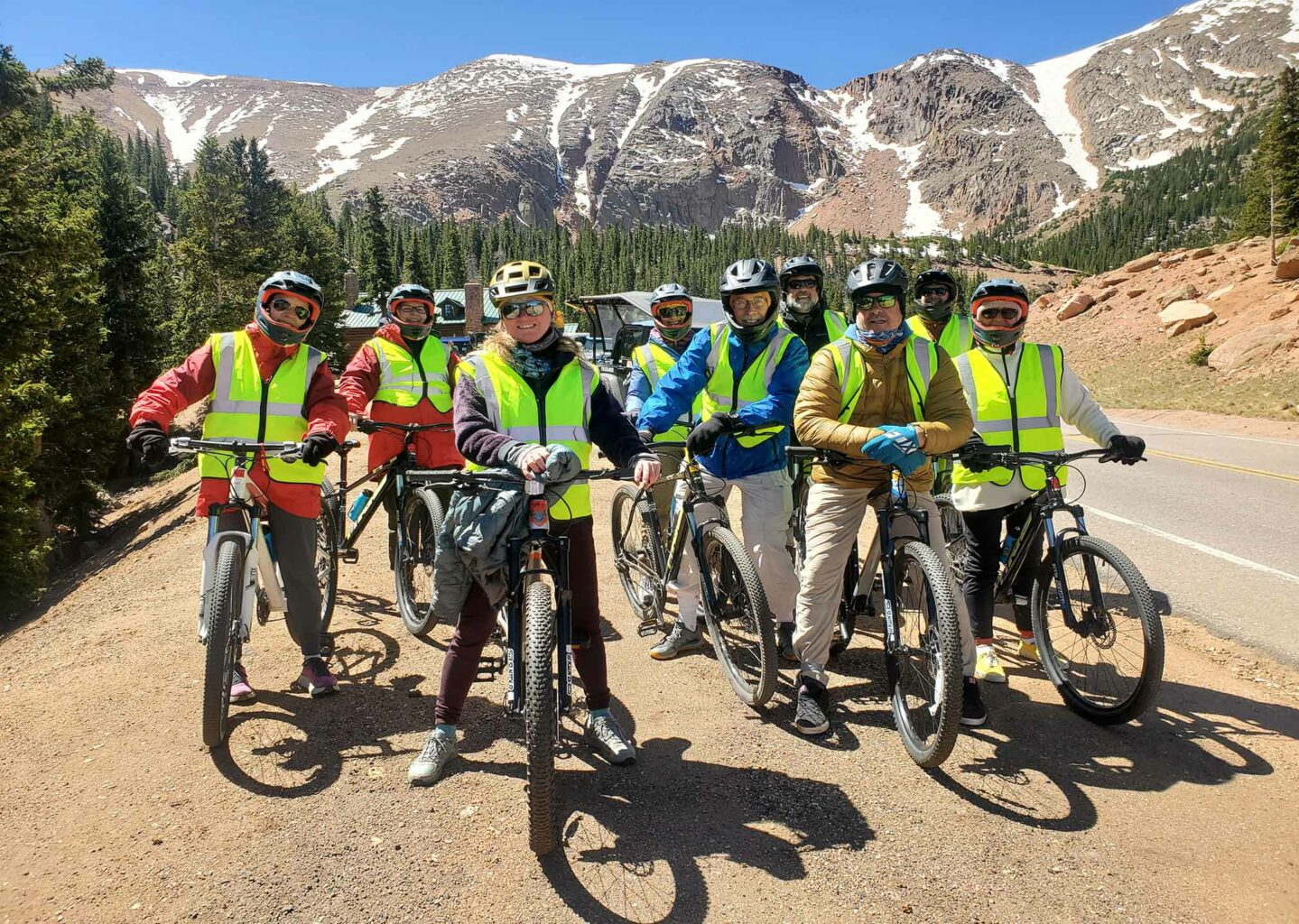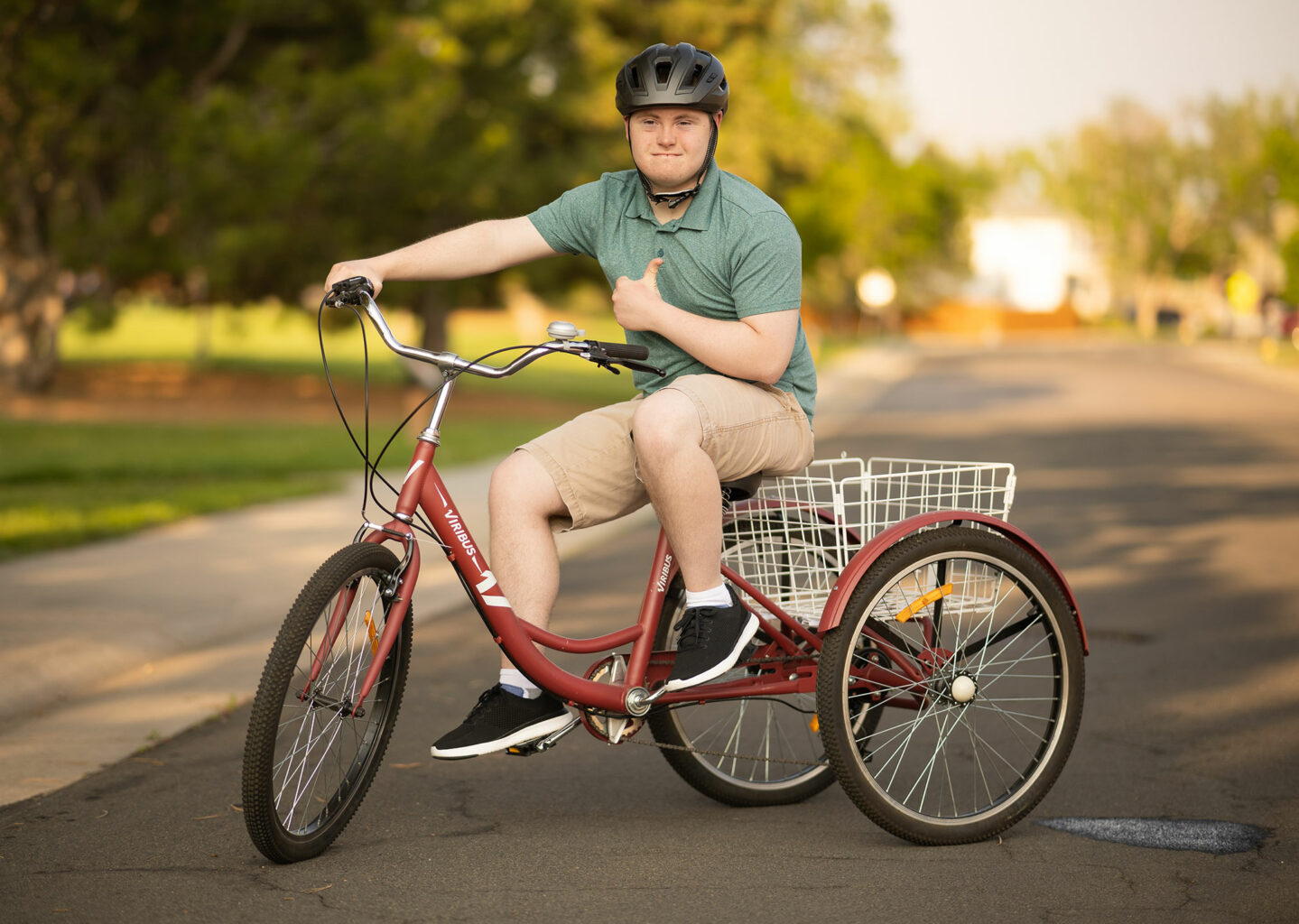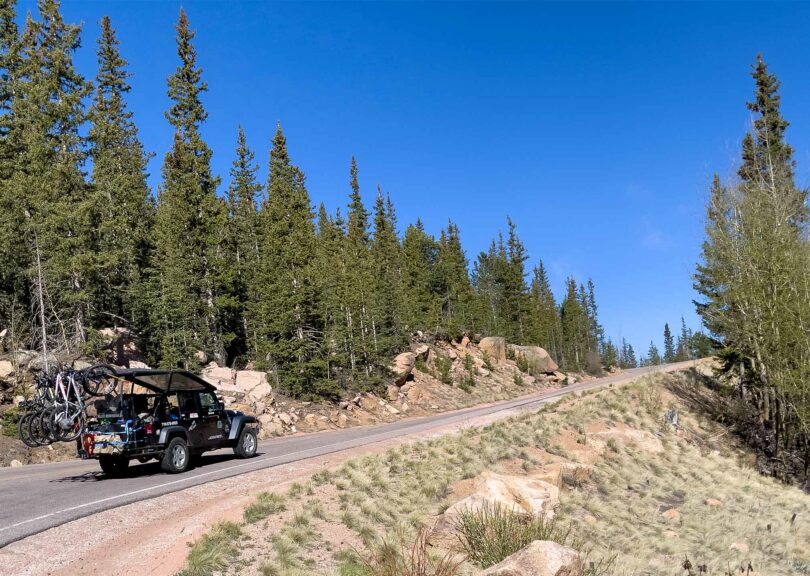By MeLinda Schnyder
The pandemic visual etched in my memory is riding bicycles with my husband 6 miles from our home in east Wichita, Kansas, to the core of the city. Once there, we would ride to the tops of parking garages for an aerial view of the mostly deserted downtown district, then take a bridge across the Arkansas River to peek through the gate of the newly-constructed-but-quarantined minor league ballpark and ride around blocks we’d never taken the time to explore.
On the return trip to our house, we’d cruise down the middle of the main thoroughfare just because we could. A few times, we even did this at 5 p.m. on a Friday when the streets would have typically been crowded with commuters heading home in their cars and others driving downtown for happy hour. With a metropolitan statistical area population close to 800,000 people (and their cars), this is not a route I normally felt comfortable riding.
I felt guilty that — for at least a couple of hours — I was able to ignore the reason we had the roads nearly to ourselves and enjoy seeing this city I’d lived in for 25 years from a new perspective: on two wheels and not worried about getting run over by traffic.
We were not alone. Though we rarely encountered other cyclists on these routes, we would see riders in our neighborhood and on the rail trail near our house. Stores couldn’t keep bikes in stock, and service departments were overwhelmed with demand. According to data gathered by bicycling advocacy group People For Bikes, cycling established itself as one of the pandemic’s most popular forms of recreation and exercise by May 2020 after remaining static since 2009.
Bicycling has been around for more than 200 years and most of us rode as kids, but it took a global pandemic to remind some of us of the benefits of riding a bicycle. I realized that, while biking was something I did regularly when traveling for work or vacation, I didn’t always take advantage of the cycling resources in my own backyard.
A CYCLING REVIVAL
Some folks needed an alternate workout when their gyms closed. Others just needed an escape from the house during stay-athome orders, especially if they were working from home and had children attending school virtually. A few likely rediscovered bicycles they forgot were in the garage until they used the shutdown to clean and declutter.
The cycling renaissance that started in spring 2020 across all demographics continues for numerous reasons, industry groups say. Year-end data compiled by the Rails-to-Trails Conservancy, the nation’s largest trails advocacy organization, shows nationwide trail use in 2022 was 45% higher than in 2019. While demand dipped 1.5% compared to 2020, the most significant year for trail use on record, it still grew 9.5% from 2021.
“When trail use spiked during the pandemic, people were flocking to the outdoors to find safe spaces to connect with each other, to find respite and to be active. It was hard to predict the long-term implications of surging trail use in 2020,” Torsha Bhattacharya, research director at the RTC, said in a 2022 release that shared the most recent data. “Now, after several years of sustained demand for trails, it’s clear that this is a trend, and that this infrastructure is essential to people across the U.S. These consistently high levels of trail use reinforce how critical this infrastructure is to our physical and mental health — as well as the well-being of our communities.”
Beyond trail counters for the numerical data, the RTC conducted an online survey about the perceptions of trails and active transportation. Respondents cited exercise, enjoying a bike ride or walk, spending time in nature, recreation and managing stress as the top reasons for using trails. Other explanations given by the bicycling community for the continued growth in interest include rising fuel prices, a focus on self-care and more bicycling opportunities at destinations and attractions, including bike-share programs and guided tours.
Other organizations including Bicycle Colorado work to make bicycling accessible and safe for everyone who rides a bike or could ride a bike in Colorado. “Bicycling is a way to experience the world and our bodies more intimately and to build greater connections than we do when we’re all in our individual cars,” Bicycle Colorado’s Communications Director Aishwarya Krishnamoorthy says. “When more people are riding bikes for transportation or for pleasure, they’re polluting the air less, they’re getting exercise and sharing joy together; they are seeing other community members and interacting with them.”
COUNTLESS RIDING OPTIONS
Every state has thousands of miles of roads and trails for bicyclists of every skill level. Colorado boasts 6,821 miles of mountain biking trails, 24,906 miles of motorized trails and unpaved roads and 1,746 miles of paved bike trails. These impressive statistics prove there are countless cycling opportunities for every type of rider and all styles of riding in the Centennial State. Whether you consider yourself a hobbyist, an enthusiast, a competitor or a commuter, you can find events and routes that feature paved roads and paths, rugged trails just wide enough for a single tire, and gravel roads offering unspoiled scenery in remote areas.
Road cycling: Cycling on paved roadways is one of the most accessible ways to ride, possibly beginning right outside your front door. Serious road riders use lightweight bikes and are committed to long, sustained rides, whether it’s on flat urban and rural roads or mountain road climbs. Many bike races happen on pavement, and commuting and recreational riding can be considered road cycling, too.
My most recent ambitious road ride wasn’t as easy as I expected when I heard “drive up, bike down” at Pikes Peak. Adventures Out West led the trip that they call the highest bike tour in the U.S. The ride starts early in the day to avoid the busiest traffic on the 19.5-mile summit road, so keep that in mind and wear layers for the day. They loan you a parka and gift you a neck gator — accept these and use them because the drive up in an open-air jeep is chilly and the temperature during the first portion of the descent from 14,115 feet is near freezing.

An Adventures Out West “Jeep Up, Bike Down” group takes a break on their Pikes Peak ride. Photo by MeLinda Schnyder.
Surprisingly, the ride is not completely downhill; there are a few spots that require some work and with the thin air, I was very winded during the first part of the descent. Fortunately, the guide stops along the way to keep the group together, take breaks and offer tips for the next section. A support vehicle follows the group to help manage vehicle traffic coming down the mountain. The ride was exhilarating, and the sweeping views of the Colorado Rockies made the effort worthwhile.
Mountain biking: MTB is one of the styles that intimidates me, more so after trying out a few trails that required technical skill I didn’t have. That means I limit myself to hiking when visiting Utah, Arizona, Vermont and other destinations with worthy MTB trails. While I’d love to cover more ground by riding, I first need to get more confidence. My plan is to find a place to learn closer to home, and fortunately that means I don’t have to miss out on an area that is making national lists as an MTB destination.
For seasoned mountain bikers, there is no shortage of trails in Colorado. Worldclass mountain biking can be found across the state. Visit cpw.state.co.us/thingstodo/Pages/Biking.aspx to find trails.
Gravel grinding: There’s an easy explanation for why gravel biking is the fastest growing style of riding: There are more than 2 million miles of unpaved roads across the country, according to the U.S. Department of Transportation.
In Colorado, where every sport seems to tend toward the extreme, gravel riding can seem intimidating to cyclists who are used to riding on pavement. But it doesn’t have to be, according to Gravel Bike Adventures founders Laura and Rose, two road cycling enthusiasts in Denver with a sense of adventure and a desire to be inclusive. “Gravel riding is all about getting off the beaten path, exploring quiet areas and enjoying nature with fewer cars.”
Their advice to combat the intimidation factor? “Start small. There are wonderful, crushed gravel trails such as the High Line Canal Trail that are non-technical and accessible to just about everyone including families. Find a group or grab a biking buddy for safety and support if you want to explore a new or more remote area.”
Laura and Rose offer three tips for a beginner gravel rider:
• Use vetted routes that are specifically recommended for beginner gravel riders until you start to feel comfortable on all the various types of gravel terrain such as loose rocks, sand, small obstacles or single track. A typical route you might find on a mapping service like Strava or Ride with GPS will show you only a map and elevation gain but tells you nothing about the types and conditions of road surfaces. A route on paper can be very different than the reality of riding it. Do your research at gravelbikeadventures.com to learn what you are getting into before heading out on the trails.
• Lower your tire pressure, especially if you are used to road biking. A typical tire pressure for smooth gravel is 40–45, and lower for chunkier conditions.
• Plan for more time to complete a gravel ride. Gravel biking requires a different kind of endurance, and because of surface resistance, your speed will be slower. You might compare it to running on sand versus running on a paved road; it can feel a lot more tiring.
Gravel grinding is the norm for riders who live on dirt roads and have access to a path right outside their front door. It also contributes to the larger conversation of bicycle tourism. According to Krishnamoorthy, the growth of gravel riding and bike tourism in Colorado helps contribute to the economies of rural Colorado by bringing in visitors who support local businesses and spread the word about the bounties of great trails and routes in these areas. “Communities such as Trinidad and Craig are pursuing bike tourism as a way to develop their economies. [Bicycle Colorado has] a strong relationship with the Colorado Tourism Office and are currently partnering with it to curate and publish resources that promote bike tourism across the state, especially in lesser-visited rural communities,” she explains.
ADAPTIVE CYCLING
In 2021, Bicycle Colorado consulted with several disability experts and advocates to create bicyclecolorado.org/adaptive, a webpage that’s full of resources, equipment suggestions and programs for adaptive cycling. “Adaptive bicycling is great because it opens the door for creativity and being understanding of other people’s needs, no matter what kind of bike they are riding or where they are going,” Krishnamoorthy says. “There are many modifications one can make to enjoy bicycling. All modifications can help people to get started or continue riding, which gives people opportunities to exercise, socialize, move around independently or with a support person, and bike for transportation or for pleasure.”

People with different needs can explore parks in Colorado using adaptive devices.
People with many different needs can modify the traditional, two-wheeled, leg-powered bicycling experience to make biking possible or easier for them. Adaptive riding is for anyone who has such a need, whether because of a disability (physical, learning, psychiatric, neurological and/or sensory); because of a short- or long-term injury; “or even because they are getting older and their knees aren’t working like they used to,” Krishnamoorthy explains.
There is a great variety of trikes, e-trikes, e-bikes and tandem bikes with various upright, recumbent, or prone seating positions, plus bikes with some other specific modifications, for riders of all ages and needs. “There are also programs, several of which are listed on our adaptive riding page, that can provide funding or grant opportunities to access these adaptive bikes, since they can be more expensive than the traditional bicycle (especially if they have an electric motor),” Krishnamoorthy says.
Sometimes, your local parks and recreation department or rec center might have adaptive bicycling programs you can participate in without needing your own bike, or they may at least know of other programs and resources that you can take advantage of.
There are also a few parks around Colorado with adaptive bike or track chair programs for people to enjoy the trails using adaptive devices. People ride on-and off-road, on trails and on the streets, and many people who are riding adaptive bikes can and do bike with their family members.
BIKING IN RURAL COLORADO
Biking to school or work isn’t just for city dwellers. “Smaller towns across Colorado benefit for the same reasons as larger communities from more people being on bikes,” Krishnamoorthy says. “Bicycle Colorado is especially seeing the promise of e-bikes as tools for transportation in communities where everyday destinations may not be very close, but people can’t or don’t want to drive between them.”
Bicycle Colorado does advocacy work and has partnered with a number of Colorado communities to create e-bike access programs, such as rebates or bike libraries. Krishnamoorthy reports that seven applicants received a combined total of $908,700 in funding this year, including organizations and communities in Cortez, Garfield County and Routt County. Bicycle Colorado is also helping the Colorado Energy Office roll out a statewide e-bike rebate program for lower-and middle-income Coloradans that should launch later this year. Several Colorado electric cooperatives offer rebates on e-bikes, so be sure to check with your local co-op before you buy an e-bike to see what opportunities are available.
If you missed out on the bicycling surge, it’s not too late to hop on. Get out and explore by bike, whether staying close to home or traveling afield.
MeLinda Schnyder is a freelance journalist. She grew up in Columbia, Missouri, where her first grown-up bike was a used, yellow Schwinn 10-speed that would now be considered vintage and cool.

